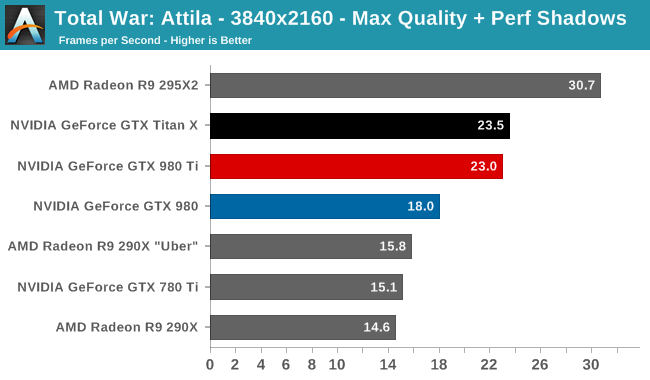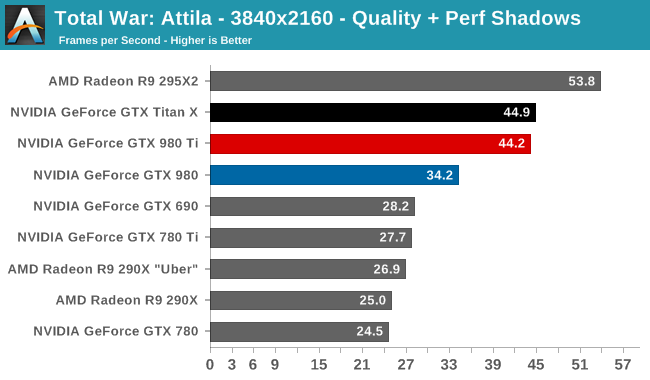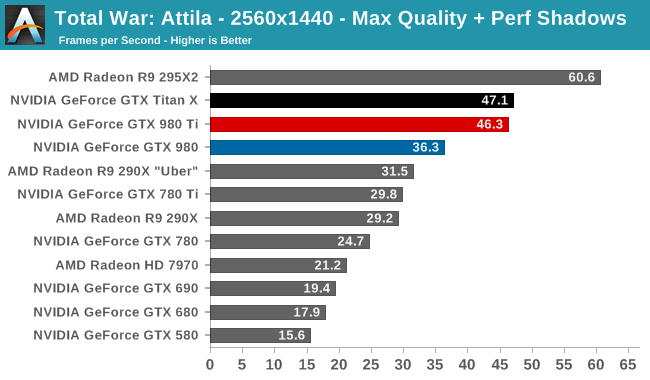The NVIDIA GeForce GTX 980 Ti Review
by Ryan Smith on May 31, 2015 6:00 PM ESTTotal War: Attila
The second strategy game in our benchmark suite, Total War: Attila is the latest game in the Total War franchise. Total War games have traditionally been a mix of CPU and GPU bottlenecks, so it takes a good system on both ends of the equation to do well here. In this case the game comes with a built-in benchmark that plays out over a large area with a fortress in the middle, making it a good GPU stress test.



Switching out to another strategy game, even given Attila’s significant GPU requirements at higher settings, GTX 980 Ti still doesn’t falter. It trails GTX Titan X by just 2% at all settings.
That said, on an absolute basis even GTX Titan X couldn't get past 30fps here at 4K with max quality settings, so the GTX 980 Ti is going to fare no better.. To get single card performance above 30fps we have to drop a notch to the “Quality” setting, which gets the GTX 980 Ti up to 44.2fps. In any case, at these settings the GTX 980 Ti makes easy work of the single-GPU competition, beating the GTX 980 once again by 28%+.










290 Comments
View All Comments
xenol - Monday, June 1, 2015 - link
Transistor count means nothing. The GTX 780 Ti has 2.8 billion transistors. The GTX 980 has around 2 billion transistors, and yet the GTX 980 can dance with the GTX 780 Ti in performance.As the saying goes... it's not the size that matters, only how you use it.
Niabureth - Monday, June 1, 2015 - link
Don't want to sound like a messer schmitt but thats 2,8K cuda cores for GK110, and 2K for the GM204. The GK110 has 7.1 billion transistors.jman9295 - Tuesday, June 2, 2015 - link
In this very article they list the transistor count of those two cards in a giant graph. The 980 has 5.2 billion transistors and the 780ti 7.1 billion. Still, your point is the same, they got more performance out of less transistors on the same manufacturing node. All 28nm means is how small the gap is between identical components, in this case the CUDA cores. Each Maxwell CUDA is clearly more efficient than each Kepler. Also helping is the double VRAM size which probably allowed them to also double the ROP count which greatly improved transistor efficiency and performance.Mithan - Sunday, May 31, 2015 - link
It matters because we are close to .16/20nm GPU's, which will destroy these.dragonsqrrl - Sunday, May 31, 2015 - link
"we are close to .16/20nm GPU's"People said the same thing when the 750Ti launched. I'll give give you one thing, we are closer than we were, but we are not "close".
Kevin G - Monday, June 1, 2015 - link
The difference now is that there are actually 20 nm products on the market today, just none of them are GPUs. It seems that without FinFET, 20 nm looks to be optimal only for mobile.felicityc - Tuesday, January 11, 2022 - link
What if I told you we are on 8nm now?LemmingOverlord - Monday, June 1, 2015 - link
@SirMaster - The reason people care about the process node is because that right now - in mid-2015 - this is an extremely mature (ie: old but well-rehearsed) manufacturing process, which has gone through several iterations and can now yield much better results (literally) than the original 28nm process. This means that it's much cheaper to produce because there are less defective parts per wafer (ie: higher yield). Hence ComputerGuy2006 saying what he said.Contrary to what other people say "smaller nm" does NOT imply higher performance. Basically when a shrink comes along you can expect manufacturers to do 1 of two things:
a) higher transistor count in a similar die size, with similar power characteristics when compared to its ancestor - and therefore higher performance
b) same transistor count in a much smaller die size, therefore better thermals/power characteristics
Neither of these factor in architectural enhancements (which sometimes are not that transparent, due to their immaturity).
So ComputerGuy2006 is absolutely right. Nvidia will make a killing on a very mature process which costs them a below-average amount of money to manufacture.
In this case Nvidia is using "defective" Titan X chips to manufacture 980 Ti. Simple as that. Their Titan X leftovers sell for $350 less and you still get almost all the performance a Titan would give you.
royalcrown - Wednesday, June 3, 2015 - link
I take issue with point b) " same transistor count in a much smaller die size, therefore better thermals/power characteristics"I disagree because the same die shrink can also cause a rise in power density, therefore WORSE characteristics (especially thermals).
Gasaraki88 - Monday, June 1, 2015 - link
Smaller nm, bigger e-peen.